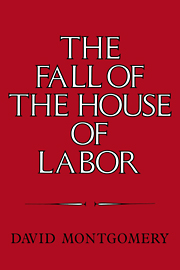Book contents
- Frontmatter
- Contents
- Acknowledgments
- Abbreviations used in text and notes
- Introduction
- 1 The manager's brain under the workman's cap
- 2 The common laborer
- 3 The operative
- 4 The art of cutting metals
- 5 White shirts and superior intelligence
- 6 “Our time … believes in change”
- 7 Patriots or paupers
- 8 “This great struggle for democracy”
- 9 “A maximum of publicity with a minimum of interference”
- Index
1 - The manager's brain under the workman's cap
Published online by Cambridge University Press: 11 September 2009
- Frontmatter
- Contents
- Acknowledgments
- Abbreviations used in text and notes
- Introduction
- 1 The manager's brain under the workman's cap
- 2 The common laborer
- 3 The operative
- 4 The art of cutting metals
- 5 White shirts and superior intelligence
- 6 “Our time … believes in change”
- 7 Patriots or paupers
- 8 “This great struggle for democracy”
- 9 “A maximum of publicity with a minimum of interference”
- Index
Summary
The regular Saturday-night meeting of Lodge No. 11 of the Rollers, Roughers, Catchers and Hookers Union stirred with excitement on June 27, 1874. There had been no work for its members since mid-April, when they had finished rolling a few thousand tons of iron rails for which they had contracted with their employer, the Columbus Rolling Mill Company, in January. Through two months of unemployment, between eleven and twenty-six of the members (who had once numbered fifty-two) had faithfully appeared at the weekly meetings and paid not only their dues but also a two-dollar weekly assessment to aid their brothers who were on strike against the giant Cambria Iron Works in Johnstown, Pennsylvania. Only Daniel Childs had refused to pay, protesting, “I don't believe in any Society that is going to take half a man earns to keep it up.” He had been expelled.
That evening a committee of four members had brought before the meeting a report of utmost importance. They had met with superintendent Christopher Lewis of the rolling mill to discuss a contract for what was described in the lodge's minutes as “the new mode of working: namely Reheating.” After sections of iron “muck bar” had been heated in gasfired soaking pits under the watchful eyes of experienced heaters, they would be wheeled on buggies to the rolling mills on which these workers would fashion them into rails.
- Type
- Chapter
- Information
- The Fall of the House of LaborThe Workplace, the State, and American Labor Activism, 1865–1925, pp. 9 - 57Publisher: Cambridge University PressPrint publication year: 1987
- 3
- Cited by



